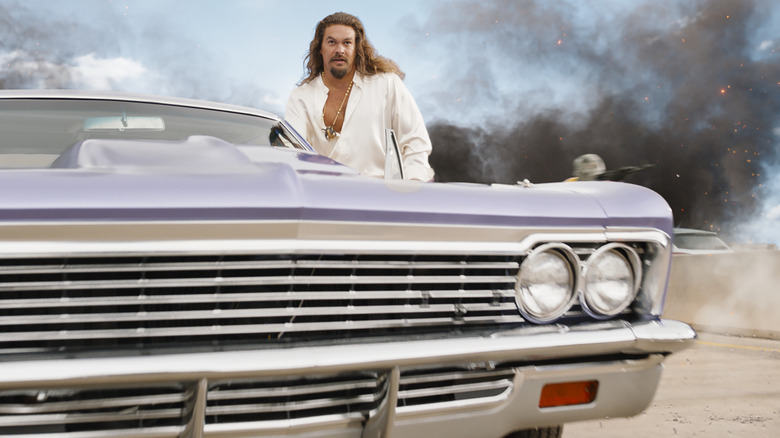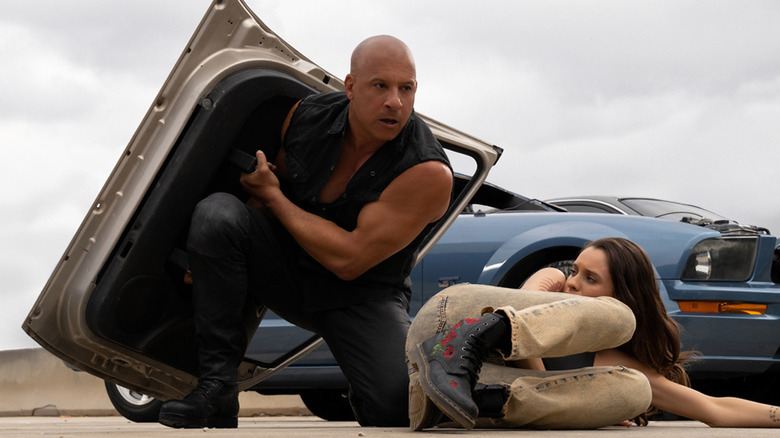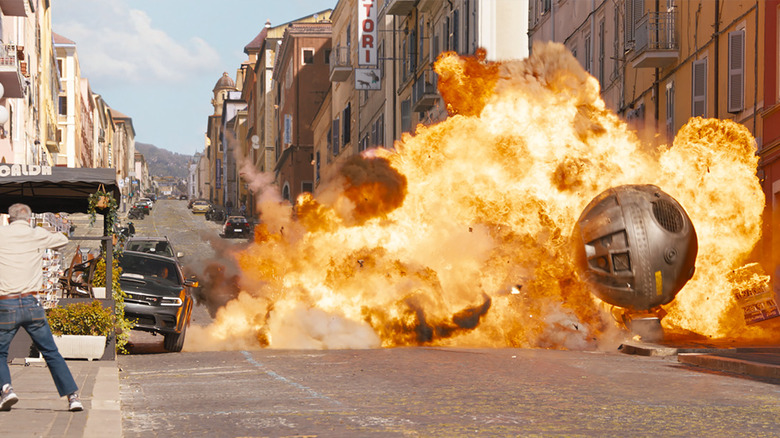Fast X Is The Modern Equivalent Of A 1940s Movie Serial, For Better And Worse
As the "Fast & Furious" movies have accumulated over the years, they have undergone a strange evolution. Some might even call it a mutation. When it started out in 2001, "The Fast and the Furious" was a mere mid-budget "Point Break" knockoff set in the high-octane world of Los Angeles street racing. It was beautiful actors driving fast cars and a transparent excuse to film women in short shorts. By the fifth film in the series, "Fast Five," the franchise had unwittingly constructed an ensemble of superheroic characters and had brazenly left physics in the dust. No longer race movies or heist movies, the "Furious" series had come to occupy the overblown espionage genre. By "Fast Five," the features had more in common with the "Mission: Impossible" movies or James Bond than they did with their direct progenitors.
With "Fast X," the 11th film in the series, the franchise has only gotten bigger and bigger. The chases are faster, the stakes are higher, and the scenarios are all the more ridiculous. In "F9," Tyrese and Ludacris flew a car into f***ing space. In "Fast X," Vin Diesel races a car down a vertical wall, hoping to outrun an explosion behind him. Every single action sequence is a tense, nail-biting, cliff-hanging "will they make it?" scenario.
Of course, the audience knows they will. The characters are now essentially immortal, eager to bound off to their next high-stakes face-off with a zip in their step. The next set piece will be disconnected from the sequences that came before, and the story will take a hiatus for each one.
With "Fast X," the "Furious" movies have finally evolved so far as an action franchise that they have, essentially, come full circle. They are now the modern version of 1940s adventure serials.
The serial era
The earliest serials began in 1914 when Pathé released the 20-chapter "The Perils of Pauline." Columbia, Universal, and Republic were also power players in the theatrical serial game.
Serials came at a time when going to the movies was an all-day affair, and audience members were welcome to come and go as they pleased while the projector ran nonstop. There would typically be two features — the bigger-budget studio "A" picture, and the low-budget genre "B" movie — with newsreels, cartoons, shorts, and serials sandwiched in between. Coming attractions would be advertised after the "A" feature, hence the name "trailers."
Serials were typically low-budget genre adventure shows, pre-TV. Installments of serials would come to theaters in regular intervals and, if a kid was attentive, they could return to the movie theater multiple times and see all 15 to 20 chapters. Republic, notably, did serials featuring Zorro, Dick Tracy, the Lone Ranger, Captain America, and Commando Cody.
By their construct, serial shorts had to pack in a lot of action in every one of its seven-minute chapters. The extant plot would be re-capped at the head (usually via on-screen chyrons), and the heroes would promptly escape a tight spot. There would be a scant moment of downtime, and then another fight or cliffhanger would occur. They were like clockwork, and kids fell in love with the format.
In "Fast X," the exact same thing happens as might in a Republic serial. Dom and his crew are attacked, but they barely escape. They spend a short time recovering. Then a new piece of information arrives, and they jet off to a new exotic locale. Once there, they experience fights and explosions they, once again, barely escape. Rinse, repeat.
"Fast X" is, essentially, a $340 million Republic serial.
This is a positive thing
Note that this is a positive comparison. There is something strangely pure about 1940s adventure serials. Their long-form storytelling left the tales feeling large, even mythic, tapping into something basic and fundamental about the cinematic medium. Film is about movement, about visual storytelling. The cinematic screen is a window into a parallel universe where we expect — as action-hungry kids — to see our fantasies about driving, fighting, and explosions reflected back. "Star Wars" was famously inspired by sci-fi serials from filmmaker George Lucas' childhood, with Lucas wanting his movie to feel as large and as epic to modern adults as the rinky-dink serials felt to him as a child.
"Fast X" is drawing from similar cinematic traditions, which connects it to cinema history.
Is "Fast X" dumb? Definitely. Is the story cogent? Somewhat. Are the characters rich and complex? Lord, no. But does it consistently find ways to wring thrills from cars, planes, bombs, submarines, airplanes, tanker trucks, and motorcycles? Yes indeed. By abandoning physics and reality, "Fast X" is free to play in the field of dreams, eager to accompany the popcorn, cola, and pectin-based fruit chews down the gullets of the audience. Our lizard brains are eager for the quick high provided by the best type of cinematic junk food. And, well, a good piece of candy is a good piece of candy.
Ultimately, "Fast X" will not deeply move its audiences. Just like the serials of yore, it doesn't have the patience to slow down and create a tone or a texture beyond what is required by a chase or an explosion. Perhaps some beloved characters will face a grim fate. But, also like in serials, characters can be brought back dramatically for whatever reason the filmmakers like.


